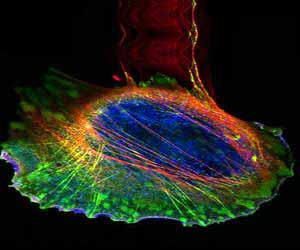Uracil DNA glycosylase protects B cell DNA which allows the proliferation of activated B cells, highlighting a new target for non-Hodgkin’s lymphoma.
- Researchers find that absence of Uracil DNA Glycosylase (UNG) results in the shortening of B cell telomeres.
- The presence of UNG protects B cell telomeres.
- Inhibiting UNG could limit proliferation of activated B lymphocytes in Non-Hodgkin’s lymphoma.
Non-Hodgkin’s Lymphoma
Non-Hodgkin’s lymphoma is a type of cancer that is found in the lymph nodes. It is most often found in a type of white blood cells called the B lymphocytes or B cells.
- It generally affects people with weakened immune system like in people afflicted with HIV.
- It is found more commonly in men than in women. Children my also be affected with non-Hodgkin’s lymphoma.
- Non-Hodgkin’s lymphoma is detected by swelling in the lymph nodes in the neck, groin and underarms.
- The individual could experience fever, pain, swelling, headache, loss of appetite and weight loss.
Activation Induced Deaminase (AID) and Development of non-Hodgkin's Lymphoma
When B cell encounters an invading cell, it releases an enzyme called activation induced deaminase (AID) that modifies the DNA. The enzyme creates changes to the DNA, mutations, that result in the production of B cells that have high affinity to the invading cells.
AID can lead to the mutation of other parts of the DNA of B-cell which are normally set right by repair mechanisms like UNG. If these mutations are not repaired, it can lead to the development of non-Hodgkin's lymphoma and other cancers.
Results of the study
- The study found that in the absence of UNG, the telomeres of B cells were affected by AID.
- This led to the shortening of the B cell genes.
- The shortened B cell telomeres limited the increase in the number of the activated B cells.
- The presence of UNG
- Repaired these gene mutations in the B cells
- This restricted the shortening of telomeres
- Allowed proliferation of activated B cells.
Dr. Verdun says “So UNG can contribute to lymphomagenesis by protecting telomeres from AID-induced damage. We show that cancerous human B cells expressing AID require UNG for proliferation, suggesting that targeting UNG may be a means to delay the growth of AID-positive cancers.”
The prognosis of a patient suffering from non-Hodgkin's lymphoma depends upon the response to chemotherapy, stage of the disease and the progress of the disease condition. A targeted therapy that tries to starve the source of cancer will aid in providing better treatment and care for patients with Non-Hodgkin's lymphoma.
References:
- What is Non-Hodgkin's Lymphoma? - (http://www.cancer.org/cancer/non-hodgkinlymphoma/detailedguide/non-hodgkin-lymphoma-what-is-non-hodgkin-lymphoma)
- All About Non-Hodgkin Lymphoma - (https://medlineplus.gov/ency/article/000581.htm)
















